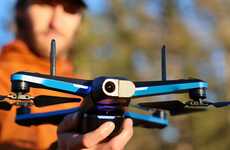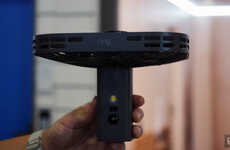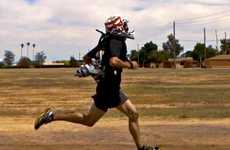
Lily Camera Uses Computer Vision Technology to Fly Without an Operator
Katherine Pendrill — May 14, 2015 — Tech
References: youtube & digitaltrends
Lily Camera is the world's first flying camera that does not require any human intervention to operate. Designers Antoine Balaresque and Henry Bradlow explain that the device should not be thought of as a drone or quadcopter, but rather "your own personal cameraman."
Separate from consumer quadcopter drones, the Lily Camera uses GPS and computer vision technology for autonomous operation. The user simply holds or wears a small tracking device that relays his or her position, distance and speed to the camera via a WiFi signal. The Lily Camera then uses its onboard sensors and computer-vision algorithms to calculate exactly how close and how high to fly in relation to the user. By tracking the users' expect location, the camera can independently take 12-megapixel stills and Full HD 1080p videos, without any direct operation.
While the Lily Camera functions autonomously, the device also comes with iOS and Android-compatible apps, which provide a live view of what the camera is recording. The user can then make basic adjustments or program flight paths if desired.
Separate from consumer quadcopter drones, the Lily Camera uses GPS and computer vision technology for autonomous operation. The user simply holds or wears a small tracking device that relays his or her position, distance and speed to the camera via a WiFi signal. The Lily Camera then uses its onboard sensors and computer-vision algorithms to calculate exactly how close and how high to fly in relation to the user. By tracking the users' expect location, the camera can independently take 12-megapixel stills and Full HD 1080p videos, without any direct operation.
While the Lily Camera functions autonomously, the device also comes with iOS and Android-compatible apps, which provide a live view of what the camera is recording. The user can then make basic adjustments or program flight paths if desired.
Trend Themes
1. Autonomous Flying Cameras - Opportunity for disruptive innovation in the development of autonomous cameras that can capture high-quality photos and videos without human intervention.
2. Computer Vision Technology - Opportunity for disruptive innovation in applying computer vision technology to enable autonomous operation of cameras and other devices.
3. Personalized Aerial Photography - Opportunity for disruptive innovation in the creation of personalized aerial photography experiences using autonomous flying cameras.
Industry Implications
1. Consumer Electronics - Opportunity for disruptive innovation in the consumer electronics industry, particularly in the development of autonomous cameras and related accessories.
2. Photography and Videography - Opportunity for disruptive innovation in the photography and videography industry through the adoption of autonomous flying cameras for professional and recreational use.
3. Tourism and Travel - Opportunity for disruptive innovation in the tourism and travel industry by incorporating autonomous flying cameras to enhance the capture of memorable experiences.
1.7
Score
Popularity
Activity
Freshness















